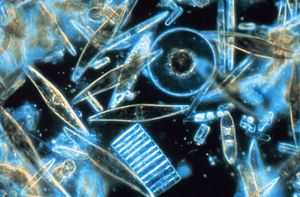Holoplankton
Holoplankton are organisms that are planktonic for their entire life cycle. Examples of holoplankton include some diatoms, radiolarians, some dinoflagellates, foraminifera, amphipods, krill, copepods, and salps. Holoplankton dwell in the pelagic division as opposed to benthic division.[1] Holoplankton is made up of both phytoplankton and zooplankton and vary in size. The most common plankton are protists.[2]
Reproduction
Holoplankton have unique traits that make reproduction in the water column possible. Both sexual and asexual reproductions are used depending on the type of plankton. "Some holoplanktonic invertebrates release sperm into the water column and females take up the sperm and fertilize the eggs. While others release the sperm and egg simultaneously in the planktonic environment in order to increase likelihood of fertilization. This release is triggered by environmental, mechanical, or chemical cues."[3]
Diatoms are single celled phytoplankton. They can appear individually or as long chains. Diatoms are important oxygen producers and are usually the first step in the food chain.[1] They are unique in their ability to reproduce sexually and asexually.[4]
Copepods are small holoplanktonic crustaceans that swim using their hind legs and an antennae.[2]
Defenses
Due to their small size and sluggish swimming abilities; holoplankton have made certain adaptations and are equipped with special defenses. Adaptations include flat bodies, lateral spines, oil droplets, floats filled with gases, sheaths made of gel like substances and ion replacement.[2] Zooplankton have adapted by developing transparent bodies, bright colors, bad tastes and cyclomorphosis. When predators release a chemical in the water to signal zooplankton; cyclomorphosis allows holoplankton to increase their spines and protective shields.[2] Studies have shown that although small in size certain gelatinous zooplankton are rich in protein and lipid.[5] "Many holoplankton seem to have very little visible defense mechanisms; therefore, it is hypothesized that a chemical defense may be possible. Pelagic cnidarians have nematocysts that eject a tightly coiled venomous thread very rapidly. These threads penetrate the surface of their target and release a venom.[6]
Asexual holoplankton
See also
Sources
References
- ↑ 1.0 1.1 Anderson, Genny. "Marine Plankton". Marine Science. Retrieved 2012-04-04.
- ↑ 2.0 2.1 2.2 2.3 Talks, Ted. "Zooplankton". Marine Life/Marine Invertebrates. Retrieved 2012-04-04.
- ↑ "Reproduction in the Plankton". Plankton. Retrieved 2012-04-04.
- ↑ Pierson, James. "What is Plankton". Plankton. University of Maryland Center for Environmental Science. Retrieved 2012-04-04.
- ↑ McClintock, James. "Feeding-Deterrent Properties of Common Oceanic Holoplankton from Bermudian Waters". Limnology and Oceanography, Vol.41. No.4. American Society of Limnology and Oceanography. Retrieved 2012-04-04.
- ↑ Bullard, Stephan. "Palatability of marine macro-holoplankton: Nematocysts nutritional quality, and chemistry as defenses against consumers". Limnology and Oceanography vol. 47. American Society of Limnology and Oceanography. Retrieved 2013-09-19.
| ||||||||||||||||||||||||||||||||||||||||||||
